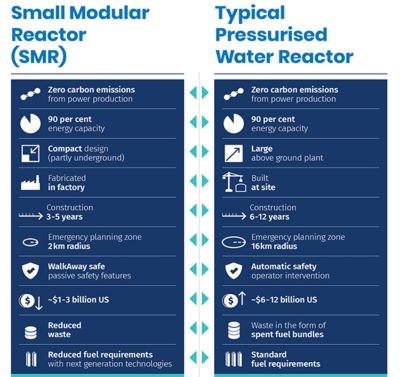Context-
In July 2024, the Government of India presented the Union Budget for FY 2024-25, outlining plans for the expansion of the country’s nuclear energy sector. One significant proposal involved partnerships with the private sector to advance research and development (R&D) for Bharat Small Reactors (BSR), Bharat Small Modular Reactors (BSMR), and newer nuclear energy technologies. This initiative aligns with India’s broader goal of decarbonizing its energy sector and achieving 500 Gigawatts of non-fossil fuel energy generation by 2030, as pledged during the COP26 Summit in 2021.
Current Legal Framework Governing Nuclear Energy
● Atomic Energy Act, 1962 (AEA): India’s nuclear energy sector is primarily governed by the Atomic Energy Act, 1962 (AEA), which grants exclusive rights to the central government to produce, develop, and manage atomic energy. An amendment in 1987 retained these provisions, highlighting the government’s cautious approach toward nuclear energy due to the potential risks involved. Section 3(a) of the AEA specifically prohibits private participation in the core activities related to nuclear power generation.
|
Recent Supreme Court Decision: ● In September 2024, the Supreme Court upheld these restrictions in the Sandeep T.S. vs Union of India & Ors. case, where a petition challenged the legality of prohibiting private sector involvement. The Court emphasized that atomic energy exploitation requires stringent safeguards to mitigate the risks of misuse or accidents. |
● The Civil Liability for Nuclear Damage Act, 2010: Another pivotal law in India’s nuclear regulatory framework is the Civil Liability for Nuclear Damage Act, 2010 (CLNDA), which ensures that victims of nuclear accidents receive compensation. The Act has faced challenges questioning its constitutionality, arguing that it violates the “absolute liability” and “polluter pays” principles. The Supreme Court is yet to adjudicate on this matter, which has contributed to regulatory uncertainty, potentially stalling private investments in the nuclear energy sector.
The Role of Private Participation
● Despite these legal constraints, the government’s recent announcement on private sector participation in nuclear energy has sparked renewed interest in exploring ways to balance the country’s energy goals with the stringent requirements of its regulatory framework.
● Historically, the Nuclear Power Corporation of India Limited (NPCIL) and the Department of Atomic Energy (DAE) have held overarching control over nuclear energy activities, involving the private sector only in peripheral areas such as engineering, procurement, and construction (EPC).
● Companies like Megha Engineering & Infrastructures and Reliance have participated in building the infrastructure for reactors, but their role in R&D has been strictly prohibited.
NITI Aayog and the Role of Small Modular Reactors
● In 2023, the DAE and NITI Aayog released a report titled “The Role of Small Modular Reactors in the Energy Transition,” which specifically outlined steps to promote private sector involvement in Small Modular Reactors (SMRs). The report identified key enablers such as the creation of a conducive regulatory framework led by national regulators and the establishment of an unambiguous civil nuclear liability structure to foster sustainable private sector participation.
● The report also noted that the private sector could contribute significantly to achieving India’s energy goals, citing potential investments of up to $26 billion. However, the existing legal restrictions under Section 3(a) of the AEA remain a major hurdle for expanding private participation beyond EPC roles.

● One of the major concerns with increasing private sector participation in nuclear energy is the issue of safety and regulatory oversight. The Atomic Energy Regulatory Board (AERB), established under Rule 35 of the Atomic Energy (Radiation Protection) Rules, 2004, is responsible for overseeing nuclear safety in India. However, concerns about the AERB’s independence have persisted over the years. The Nuclear Safety Regulatory Authority Bill, 2011 was introduced to address these concerns, but it was never enacted into law.
● The absence of a robust, independent regulatory framework poses a significant challenge to attracting private investments in India’s nuclear energy sector. Addressing this will require a comprehensive restructuring of the AERB and possibly revisiting the stalled Nuclear Safety Regulatory Authority Bill.
Possible Model for Private Sector Participation
● Given the legal and regulatory restrictions, one possible approach to involving the private sector is through Public-Private Partnerships (PPP), where the NPCIL or a similar government entity retains majority ownership (51%) of nuclear plants. This model would allow private entities to contribute capital and technological expertise while keeping overall control and accountability with the government. Such a structure aligns with existing legal provisions and ensures compliance with the AEA.
● Additionally, by maintaining majority government ownership, these entities would fall under the Right to Information (RTI) Act, 2005, enhancing transparency. Public accountability could be ensured through mandatory disclosures under Section 4 of the RTI Act, with responses to public inquiries under Section 6.
● One of the major challenges in nuclear energy is managing the risks associated with accidents. The Chernobyl disaster (1986) and Fukushima Daiichi accident (2011) serve as stark reminders of the devastating consequences of nuclear incidents. In India, the CLNDA mandates a “no-fault” liability regime, where the operator bears strict liability for any nuclear incident. The pending challenge to the CLNDA’s constitutionality adds another layer of complexity, as the Supreme Court is yet to resolve key issues related to nuclear safety and compensation principles.
● The 2013 judgment in G. Sundarrajan vs Union of India and Ors., which dealt with protests surrounding the Kudankulam Nuclear Power Plant, also highlighted the need for regular inspections, safety reports, and due diligence by government bodies. These rulings underscore the importance of stringent safeguards in the sector, particularly when private players are involved.
India’s Nuclear Energy Ambitions
● According to the World Nuclear Association (September 2024), India has proposed an incremental increase of 32 GWe in its nuclear energy capacity. However, achieving this goal will require significant capital and highly skilled resources due to the technical complexity and inherent risks of nuclear energy.
● The NITI Aayog report and the Union Budget proposal highlight the importance of private sector participation, particularly in the R&D of new technologies such as SMRs and BSRs. However, the restrictions under the AEA and the ongoing litigation surrounding the CLNDA create a challenging environment for private investments.
The path to private participation in India’s nuclear energy sector is fraught with legal, regulatory, and safety concerns. While the government’s proposal to involve private players in developing new nuclear technologies aligns with the country’s energy decarbonization goals, significant legislative reforms are required.
Revisiting the AEA’s restrictive provisions on private sector involvement in R&D, clarifying the civil liability framework, and strengthening regulatory oversight through an independent body are critical steps to creating an environment conducive to private investment. Public-private partnerships, where the government retains majority ownership, may offer a feasible model for navigating these challenges while ensuring safety and accountability.
Ultimately, India’s ambition to expand its nuclear energy capacity will depend on striking the right balance between leveraging private sector expertise and maintaining stringent regulatory controls to prevent accidents and ensure public safety.
|
Probable Questions for UPSC Mains Exam- 1. What are the main legal and regulatory challenges hindering private sector participation in India's nuclear energy sector, and how could public-private partnerships address these issues? (10 Marks, 150 Words) 2. How does the Civil Liability for Nuclear Damage Act, 2010 contribute to regulatory uncertainty, and what are the implications for private investments in India's nuclear energy infrastructure? (15 Marks, 250 Words) |
Source- The Hindu








